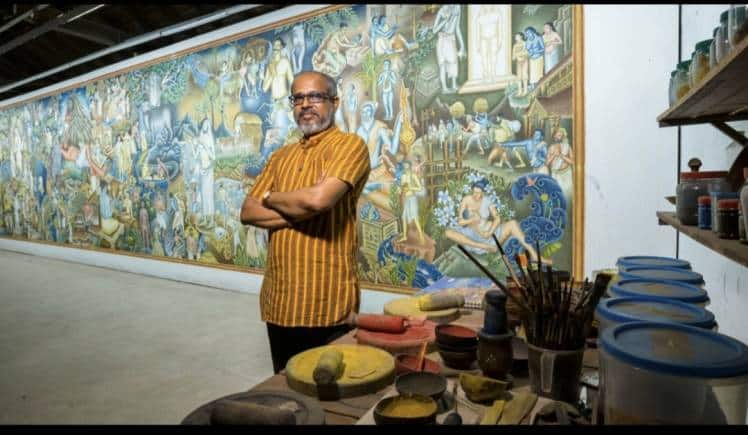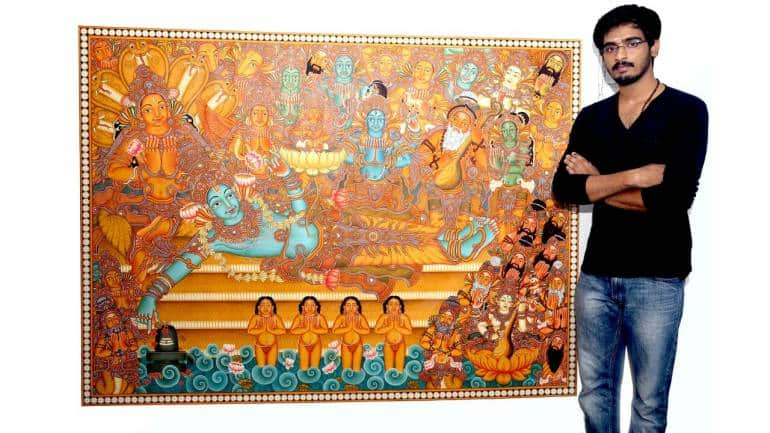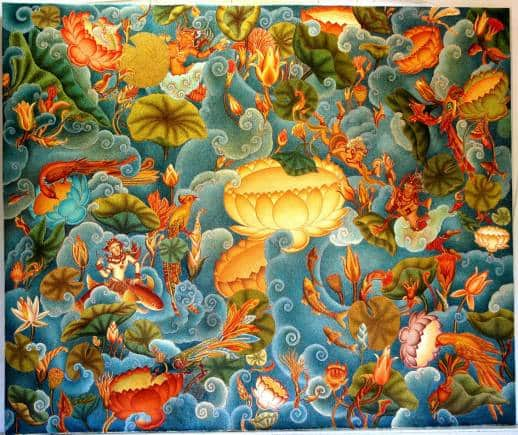



For centuries, exquisite murals have adorned the walls of Kerala temples and palaces, some of which remain intact albeit dulled over the centuries. Noteworthy examples of these magnificent mural paintings can be found adorning the walls of the Mattancherry Palace in Kochi, Thirunandikkara Temple near Kanyakumari in Tamil Nadu, and places of worship like the Guruvayur and Ettumanoor temples. What began as a practice under royal patronage, likely between the ninth and 12th centuries, drawing inspiration from Sanskrit texts such as the Chitrasoothram (by Vishnudharmottara, 6th century), Kerala's mural painting is now undergoing a remarkable transformation, shifting from expansive walls to the realm of canvas.
 A work by mural-painting artist PK Sadanandan.
A work by mural-painting artist PK Sadanandan.
Increasingly, students of the Kerala mural painting have been trained in the art on canvas rather than on the wall. For instance, at the ongoing art show in Bengaluru, organised by the Chitrasopanam Art Foundation based in Kozhikode, Kerala, 39 students have displayed their paintings on canvas, after a two-year course under the guidance of artist Sasi Edavarad. The large-scale works have been done mostly in acrylic colours, another shift from the tradition.
Johny ML, art historian, curator and writer, believes that today the art form is a ‘trendy thing’ all over the world. “There are two streams of Kerala mural art now; a set of artists sticking to the mural tradition, and another set, experimenting with the contemporary and literary themes using the conventional mural language.”
 Mural artist PK Sadanandan with his artwork.
Mural artist PK Sadanandan with his artwork.
PK Sadanandan belongs to the latter category, delving into more contemporary subjects. He has participated in prestigious exhibitions like the Kochi Muziris Biennale (2016) and Lokame Tharavadu, organised by the Kochi Biennale Foundation. He was one of the first students to be trained under Mammiyur Krishnan Kutty Nair at Guruvayur Devaswom Mural Painting Institute (founded in 1987). This renowned school was keen on getting the murals ‘outside’ from the temples. Reflecting on his early experiences, Sadanandan shares, "My guru was the first to attempt painting on asbestos sheets, which were readily available at the time but the sheets would break easily. My guru was disappointed with the results. In search for newer mediums, we tried to practice on canvas but in those days, the canvases had oil primer which made it difficult to paint with natural colours. So, we would hand wash the canvases and dry them before using.”
As a professional artist, Sadanandan took matters into his own hands. For a group exhibition held at Pragati Maidan, New Delhi, in 1992, he personally prepared canvases using cloth sails sourced from fishing boats in Kochi. His unique choice of material and art caught the eye of designer Rajiv Sethi, who commissioned Sadanandan to create murals in Mumbai. Thus, the aesthetics of Kerala mural art began to transcend geographical boundaries.
 Mural artist Vishnu P Vikraman with his artwork.
Mural artist Vishnu P Vikraman with his artwork.
"The advantage of canvas over walls," mural artist Vishnu P Vikraman asserts, "lies in the fact that the beauty of Kerala mural painting can now be appreciated anywhere in the world. The paintings can now be passed on over generations." Vikraman studied Kerala mural art from the Shankaracharya University of Sanskrit in Kalady, Kerala and apart from a MFA in mural painting from Viswa Bharati University in Santiniketan, he has also studied Thai mural painting. Most of his works are done on canvases and he uses both natural and acrylic colours. He highlights the vulnerability of mural paintings on walls, which are susceptible to destruction, exemplified by the devastating fire that ravaged the Guruvayur Temple in 1970. When the authorities sought to redo the walls, they discovered only a handful of artists, like Mammiyur Krishnakutty Nair, Pattambi Krishna Varier, MK Sreenivasan, and KK Varier, were capable of restoring the murals. It emphasized the fact that the dying art, a decline associated with rise of Raja Ravi Varma's works on canvas, was at greater risk. This realisation resulted in the establishment of the Institute of Mural Painting by the Guruvayur Devaswom.
The traditional mural painting skills require dedication. Just the brush which is used to sketch is made from arrow grass collected from Desamangalam in Thrissur where there is a ‘broom’ hill. A whole day of foraging yields just a bunch of grass that’s boiled in milk before making the brush. The process of making the colours take two to three weeks. Laterite is collected or purchased from around Mookambikam Temple, grinded with a mortar and mixed with water to get the ‘chai’ colour. Yellow and red colours are prepared from stones which are powdered, mixed with water and ground, then purified. At the time of application, tree and fruit saps are added. The green and blue colours come from the juice of Neelamari leaves and black colour is simply the soot collected by burning mustard oil. There are exacting rules in sketching, colouring, and themes as well.
The shift to the canvas has led the art to change in several ways. Since canvases are available specifically for acrylic colours, most artists opt for those colours. According to Sadanandan there are two reasons. One, the arduous and time-consuming process of making natural colours and two, acrylic colours possess a liveliness that surpasses the softness of natural colours. “To paint a 4ft x 3-inches canvas with natural colours, I would probably take one month whereas it will take just 10 days to paint with acrylic colours.”
 A work by mural-painting artist PK Sadanandan.
A work by mural-painting artist PK Sadanandan.
As the art of mural painting is undergoing significant changes, Sadanandan and artists like him believe they were the ones who actually had to struggle to master the art. Only then, could they find their own individual styles. Sadanandan, for example, has incorporated Ajanta colors, experimented with a black and white palette and even a predominantly blue palette. He has painted biblical themes in churches. Vikraman, inspired by Thai mural art traditions, uses golden colour for ornamental details.
Vikraman acknowledges certain challenges in using canvas. The process of preparing a canvas involves washing, to strip off the primer, and drying before it can be used. “When a canvas goes through this process, its fibres shrink,” Vikraman explains. When sketching on such a soft surface, the alignment of the lines can become altered. “In Kerala mural painting there is very strong measurements and character alignment is crucial. Any slight mistake, the entire aesthetic is ruined.” Despite such issues, the Kerala mural painting is seeing its place on canvas. But the wheel may turn once again. “This generation has moved to canvas but maybe, the next generation will go back to the wall,” Vikraman says.
Discover the latest Business News, Sensex, and Nifty updates. Obtain Personal Finance insights, tax queries, and expert opinions on Moneycontrol or download the Moneycontrol App to stay updated!
Find the best of Al News in one place, specially curated for you every weekend.
Stay on top of the latest tech trends and biggest startup news.